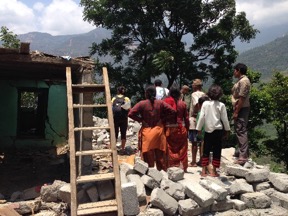With the growing danger of natural disasters, the race is on to expand access to programs that safeguard lives from the human-made danger of poorly built housing. With the common mission of building safer, stronger structures, Build Change and Simpson Strong-Tie have partnered for the Simpson Strong-Tie® Fellowship for Engineering Excellence program. This year’s fellow is Build Change Engineering & Design Services Director Tim Hart, SE. As with our previous fellows, Hart is documenting his journey with the program on the Simpson Strong-Tie Structural Engineering blog.
One of my colleagues asked me an interesting question recently: “What if there was an earthquake in the middle of this pandemic?” His question regarded how buildings would be inspected and tagged after an earthquake, since that would require inspectors to go inside buildings to look for damage. I responded to him in that context, saying that inspectors will likely already have personal protective equipment (PPE) and will already be trained to act safely and responsibly. However, his question led me to think about the larger implications of his question, beyond just the logistics of post-earthquake building inspections.
What would happen if there was an earthquake in the middle of a pandemic? How would hospitals already full with COVID patients be able to treat hundreds or even thousands more injured people? How can emergency shelters house people displaced by a damaged house and also practice social distancing? Or, for that matter, clean hygiene? (Remember what happened in the New Orleans Superdome after Hurricane Katrina!) How can anyone shelter in place when their shelter has collapsed? How will people already suffering from the loss of their job be able to handle the loss of their home?

Earthquake risk is tied to probability. The higher the odds of an earthquake happening, the higher the risk; and the higher the risk, the higher the requirements are for designing buildings strong enough to withstand earthquakes. Since the probability of an earthquake happening at any specific point in time is very low, we usually do not think about the risk of an earthquake happening right now or within the next few months. However, that risk is still present, and the longer this pandemic lasts the higher the risk that there will be an earthquake while the virus is still actively spreading. Since hurricanes and typhoons are much more frequent than earthquakes, the risk of one occurring during the pandemic is even greater. In fact, according to NOAA (the National Oceanic and Atmospheric Administration), there is a 60% chance that the 2020 Atlantic hurricane season will be worse than normal.
So what do we do? We could hope that there won’t be a large earthquake or hurricane in the next six to 12 months. The odds would appear to be in our favor and it gives everyone a reason not to think about this scenario. However, that would be a gamble, and the stakes are very large. The lives of millions of people are at stake.
Right now in Puerto Rico, Sint Maarten and other islands in the Caribbean, communities are having to deal with the COVID-19 pandemic while still in the process of rebuilding after Hurricanes Maria and Irma from 2017. Three of the countries where Build Change works— Colombia, Indonesia and the Philippines — are among the 30 countries with the highest number of confirmed COVID-19 cases and are also among the countries most vulnerable to an earthquake and/or typhoon.

For the last few months, I have been working with Build Change’s Indonesia team on developing guidelines and training materials for safer housing construction in East Java. East Java also has the highest COVID-19 case rate in Indonesia. Even though the pandemic has affected our ability to deliver the training, our team, along with our partners the American Red Cross and the Indonesian Red Cross Society (PMI), have persevered with our work and made accommodations to provide the training in as safe a manner as possible for both the trainers and the trainees. Build Change is making similar efforts in the Philippines, Colombia and Nepal.
The pandemic has forced me to spend most of my Fellowship working from home instead of travelling to each of the country programs as was originally planned and as the two Fellows before me were able to do. It has also forced me, as well as all my Build Change colleagues who are also working from home and unable to travel, to figure out new ways that we can continue to promote safer housing and safer schools not only during the pandemic but also after it is over. The world may be a different place than it was six months ago, but the need for safe housing and schools is as critical as ever, if not more so now.
This pandemic has shown us that our houses and schools not only have to be safe to occupy after an earthquake or a hurricane. They also have to be safe to occupy during a pandemic. For millions of people, though, their financial situation will not allow them to have a safe house, unless they are given access to financial resources (such as microcredit) to make resilient improvements to their homes. They are the people at risk of ending up in shelters or hospitals that cannot accommodate them. They are the people who risk having nowhere to shelter in place. They are the people who would need to homeschool their children without either a home or a school.

They are the people that we at Build Change work for. They are the people for whom we work to provide a dignified house (casa digna) in Colombia, a durable house (tibay balay) in the Philippines and a safe house (rumah aman) in Indonesia. They are the people I admire and respect for their resilient spirit. They are the people that I am thankful to Build Change and Simpson Strong-Tie for giving me the opportunity to help.


